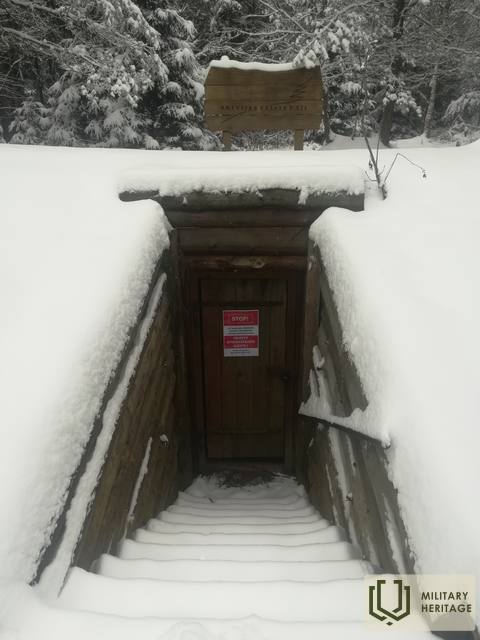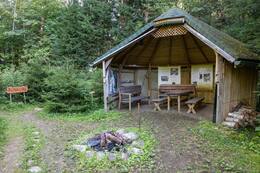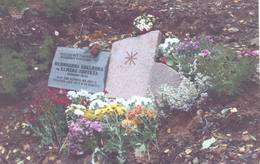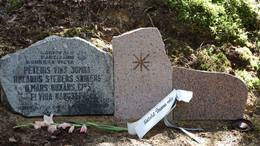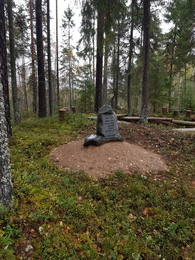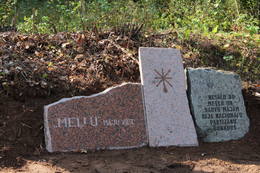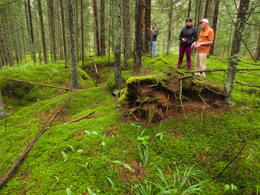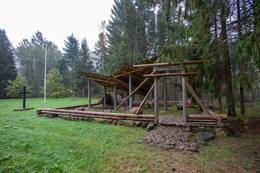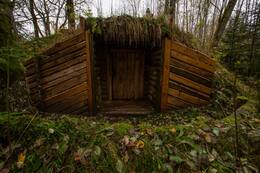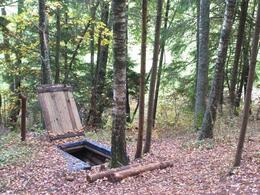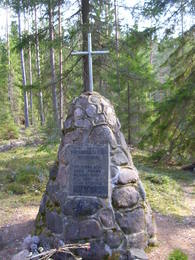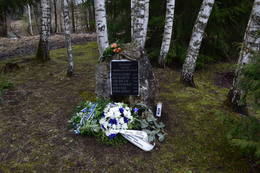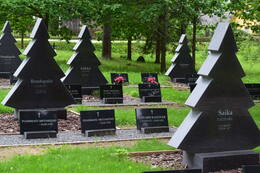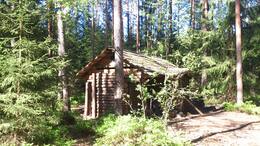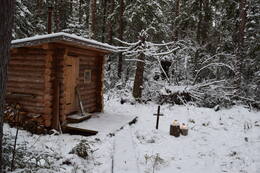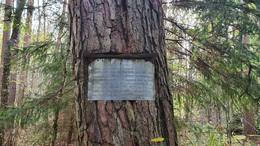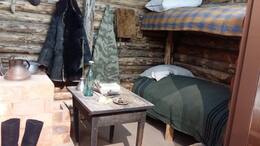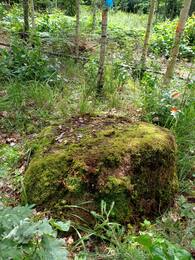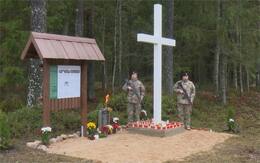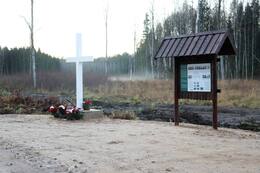Partizan/Guerilla bunker
III National Partizans, II World War II, IV Soviet Occupation
An underground or semi-underground base in a forest, swamp or other inaccessible location, mostly remote from populated areas, where members of an armed resistance movement and their supporters can take refuge.
In order to understand this page of history, several National Partisan bunkers have been restored and can be visited by everyone. There are bunkers in Ile, Amata and between Vietalva and Jaunkalsnava.
The partisan bunker in Īle is one of the largest bunkers in the Baltic States, built in 1948 by the partisans of the united Latvian-Lithuanian group. The bunker was built as a temporary headquarters to spend the winter of 1948/1949 in the forests of Īle. A few months later, the bunker was discovered and attacked by the State Security Committee. After a five-hour battle, 15 partisans died and nine were taken prisoner. Thanks to the support of JSC "Latvijas valsts meži", the bunker has been restored and its furnishings have been preserved as they were in the winter of 1948. The Īle National Partisans' Bunker is open to the public at any time of the day or night.
More information sources
Latvian national partisan struggles - National Encyclopedia (enciklopedija.lv)
Related timeline
Related objects
Bunker of national partisans – Forest Brothers
The Forest Brothers’ Bunker is located by the Riga-Pskov (A2) highway 76 kilometres from Riga and 11 kilometres from Cēsis. The Latvian national partisans or Forest Brothers were small, armed groups of local residents who fought their independent battles against the occupation regime of the USSR in the territory of Latvia from 1944 to 1956. Forced to hide in the forests, these were people who could not or did not want to live in the Soviet Union. A total of around 20,193 Forest Brothers operated in Latvia. The bunker was formed based on the stories and memories of former Forest Brothers about life in the forests, hiding and fighting for the independent state of Latvia after 1945. The bunker showcases armaments and household items. The personal belongings, weapons and photos of partisans are on display. The guide’s narration is enriched by a video from interviews with Forest Brothers. There is a place for picnic campfires by the bunker. It is possible to pre-order a soup prepared on the fire or enjoy an evening of outdoor cinema by the fire.
Memorial plaque to the Veclaicene national partisans at the site of the bunker
Located in Veclaicene parish, Alūksne region.
Opened on October 4, 2019. Stonemason Ainārs Zelčs.
On March 13, 1953, in the Veclaicene forests near the "Koruļi" houses, the Chekists discovered a carefully camouflaged bunker and arrested Bernhards Ābelkoks and Elmārs Tortūz.
Weapons were found in the bunker: 2 German rifles and 95 cartridges, 2 “Parabellum” pistols and 152 cartridges.
On November 11, 1949, Cheka agents shot K. Dokti-Dokteniekus, and his group disintegrated. After the attack, B. Ābelkoks and E. Tortūzis hid for some time in a bunker near the “Maskaļi” houses, but from the spring of 1951, with the support of Ilona Ābolkalna, they set up a bunker in “Koruļi”, where they lived until their arrest.
Memorial site of the bunker of the national partisan group “Jumba”
Located in Ziemers parish, in the 66th block of the State Forest.
The memorial was opened on July 10, 2020.
In the second stage of the Latvian national partisan movement, in mid-1948, a group of 4 people - Viks Pētersi, Stebers Rolands, Bukāns Ilgmārs and Kangsepa Elvīra separated from the J. Bitāns-Liepačs unit in the territory of Mālupē-Beja parishes and began independent activities in Ziemera-Jaunlaicene-Veclaicene parishes. The partisan headquarters was near the Estonian border, not far from the Riga-Pskov highway, on a hill, in a well-built bunker.
On March 2, 1950, when the Chekists discovered the bunker, the partisans hid in a barn built of boulders in the “Napke” house on the Estonian side. After a long and intense firefight, on March 3, 1950, the Chekists managed to set the barn on fire. Ilgmārs Bukāns, Rolands Stebers, and Elvīra Kangsepa burned to death along with their newborn daughter. Pēteris Viks jumped out of the barn window and hid in the attic of the house, where he was found and shot. The farm was burned down. The bodies of all the fallen partisans were taken to Alūksne. A memorial sign was erected at the site of the fighters’ deaths in the early 1990s. Elvīra Kangsepa’s daughter, who was born in the burning barn, was named Liesma.
Memorial site "Bitāna Bunkers"
Located in Mālupe parish, Alūksne municipality.
The memorial stone was unveiled on October 13, 2017. Stonemason Ainārs Zelčs.
On August 24, 1945, in Latgale, in the Dubna forests, the Latvian National Partisan Association (LNPA) was founded with the aim of restoring the 1918 Republic of Latvia. For better coordination of the activities of the partisan groups, regional headquarters were established. The national partisan groups operating in the Beja, Mālupė, and Mārkalne parishes united in the “Priedolaine” sector. The regional headquarters was headed by Jānis Liepacis. Propaganda departments were established in each regional headquarters. One of these, commanded by Jānis Bitāns, was established in the forest massif of Mālupė parish. Here, in the bunker, from 1946 to 1948, five press publications of the Latvian National Partisan Association were printed: “Mazais Latvis”, “Liesma”, “Auseklis”, “Māras Zeme” and “Tautas Sargs”. The Alūksne Gymnasium youth resistance movement “Dzimtenes Sili” was involved in the preparation and dissemination of information.
Memorial stone in Ilzene near the houses of “Sarvi” and “Meļļi”.
Located in Ilzene parish, Alūksne municipality.
The memorial stone was unveiled on September 28, 2018. Stonemason Ainārs Zelčs.
The residents of these houses in Ilzene parish from the autumn of 1944 supported the national partisans led by Voldemars Andersons (“Vecs”), whose bunker was located nearby in the thicket of the forest. On November 23, 1945, the bunker was surrounded by NKVD soldiers. Nine fighters died in the battle. After it, 2 machine guns, 14 automatic rifles, 11 rifles, 10 pistols, 3,500 cartridges, 45 grenades, 4 binoculars were found. The destruction of Voldemars Anderson’s group was planned in the Cheka agency’s case “Chain” (“Цепь”).
The group consisted of Voldemārs Pāvels Andersons ("Vecais"), Gastons Dzelzkalējs, Voldemārs Tonnis, Centis Eizāns, Osvalds Kalējs, Jānis Koemets, Stāvais ("Polis"), Voldemārs Rappa, Eduards Rappa, Elmārs Rappa (remained alive).
Possible location of Otomars Oškalns bunker
A remote and difficult-to-access location is a large forest massif about 200 m west of the Žega River and about 0.5 km southwest of the Žega floodplain. It is recommended to go to the mentioned place on foot or by bicycle, using LIDAR maps and geographical coordinates. In the mentioned place, there is a natural dune ridge about a kilometer long (in the W – E direction) and half a kilometer wide (in the N – S direction), covered with coniferous forest. In the upper parts of the northern and eastern slopes of the dune massif, there are well-preserved trenches, presumably from the Second World War. Harijs Jaunzems (a former engineer of the Ķegums HPP) believes that a bunker of a Red Army partisan unit formed by Otomars Oškalns was located in this area (the specific point is unknown).
Memorial site "Daiņkalni" of the national partisans led by Dailonis Breikšis
Located in “Daiņkalni”, Rauna parish, Rauna region (near the “Mežviju” houses in Smiltene region, Branti parish.
Access to the memorial site is only possible once a year - on April 16th! The road leads through private property.
The memorial site was established on the site of the former houses of “Daiņkalni” and “Graškalni” in Rauna parish, under which a group of national partisans led by Dailonis Breikšs (nickname Edgars, 1911-1952) hid in bunkers from 1950 to 1952. D. Breikšs’s national partisan group was established in 1948 and until 1950 they lived in “Jaunvieslavēni” in Gatarta parish with their landlord Kārlis Lāčis. In 1950, D. Breikšs’s partisan group was betrayed by his own brother Laimonis, so they were forced to move. They lived in the forests during the summers, but spent the winters in “Daiņkalni” in Rauna parish with forester Artūrs Pērkons (1907-1952) and in bunkers built under houses in the nearby “Graškalni”.
Since 2002, the memorial site in “Daiņkalni” has been gradually improved. Every year on April 16, memorial events are held in memory of the national partisans led by Dailonis Breikšs. In April 2003 and 2004, memorial crosses and plaques were dedicated near the houses of “Daiņkalni” and “Graškalni”. In the fall of 2016 - spring of 2017, with the help of local Raunė residents, the memorial site was reconstructed according to the sketches of architect Z. Butāns, and the site of the former bunker was excavated and strengthened.
Memorial site of national partisans in Sērmūkši
Sērmūkši is home to one of more than a hundred memorials to partisan battles in Latvia. There are more than six hundred partisan battle sites in Latvia. A Latvian national partisan dugout has been built based on historical evidence, and visitors can spend the night in near-authentic conditions with plank beds, lighting provided by kerosene lamps and a heating device similar to the ones used by partisans. Visits must be booked in advance. The fateful moment for the Sērmūkši National Partisan Group came on 29 November 1946 with the deaths of four fighters from the group: Jānis Zīrāks, Reinholds Pētersons, Jānis Pīlands and Anna Zariņa. Alfrēds Suipe survived, endured deportation, returned to Latvia and saw the restoration of a free state. He initiated the idea to establish a memorial site for his fallen companions in Sērmūkši.
Metsavenna Farm in Võrumaa
Forest Brother Farm is close to the Latvian border in the village of Vastse-Roosa.
The bunker tourism attraction was opened in 1999, offering visitors a chance to experience the Forest Brothers’ way of life as a chapter in Estonian history. The programme includes searching for Forest Brothers in the hideout, visiting the bunker, learning about real-life events, singing Forest Brother songs with the host and sampling a Forest Brother meal or feast. The main attraction is the bunker, which is lined with narrow pine logs and embedded in the hillside. The bunker is furnished with bunk beds and a small table. These types of bunker were used during the late 1940s and early 1950s by hundreds of brave men in the resistance, burdened by the need to hide from the authorities.
Monument to Forest Brothers in Puutli
The Puutlipalo monument and bunker site is situated in the village of Mutsu in Võru County. On 28 March 1953 the last large-scale skirmish took place between the Forest Brothers and the Soviet security forces in Puutlipalo. All eight people hiding in the woods were killed – three women and five men. The bunker was destroyed and the bodies brought out of the forest and buried in an unknown location.
This monument, dedicated to the fallen Forest Brothers, was unveiled on 20 May 1989 near the former site of the bunker. It was the first monument to Estonian resistance fighters erected while the country was still under Soviet occupation and the Forest Brothers were still officially referred to as bandits. Contrary to many similar monuments erected later, which were blown to pieces by the communists, the monument in Puutlipalo remained untouched owing to its hidden location. The original stone tablet is the only feature to have been replaced, as it was mistakenly inscribed (due to years of being kept secret by the state) with the name of a resistance fighter who died in another battle.
DNA tests done during an investigation by the Internal Security Service in January 2013 revealed the identities of the eight Forest Brothers killed in Puutlipalo. On Resistance Fighting Day that year they were reinterred in the cemetery in Vastseliina.
Memorial to Forest Brothers in Saika
The Battle of Saika Bunker took place on 7 March 1951. The skirmish, which lasted for four hours, was one of the few in the history of the Forest Brothers in which the Soviet forces racked up losses comparable to those of the Forest Brothers themselves. Out of the eight Forest Brothers in the bunker, only two managed to escape. They were killed two years later in the Battle of Puutlipalo.
The memorial was opened on St John's Day in 2007 next to the main road. Avid hikers will also find the site of the bunker if they follow the forest paths south-east of the memorial for 700 metres. Battle site coordinates: 57°39'22.2”, 27°18'49.9" Note: Note that the coordinates carved into the Saika memorial spruce in the cemetery in Vastseliina are inaccurate.
Memorial for Forest Brothers at Vastseliina
Plans for this Forest Brothers memorial were hatched in early 2013, when the Internal Security Service identified the bodies found in a mass grave in Reedopalo near Võru. With the cooperation of Vastseliina municipality, the Võru regional unit of the Estonian Defence League and the Ministry of Defence, the location in the cemetery was decided upon and the necessary preparations were carried out. The reinterment of the 13 Forest Brothers took place on 21 September 2013. A year later, memorial sculptures designed by Mati Karmin were unveiled here, depicting small spruce trees carved out of stone. On 1 November 2015 a further four Forest Brothers whose bodies had been recovered from the secret mass grave in Reedopalo were reinterred here and more memorial spruces were unveiled in remembrance of those fallen in three different battles. Their actual graves remain unknown to this day.
Põrgupõhja Forest Brothers' Bunker
Põrgupõhja Bunker is situated in the woods near the village of Tiduvere in Rapla County.
By 1945 anti-Soviet dissent had developed into organised resistance movements in many occupied lands, including Estonia. Attempts were made to unify fighter groups and establish a network. This bunker, built in 1947, was an important stronghold for the Forest Brothers.
Fully reconstructed, Põrgupõhja Bunker was opened in 2015, showcasing the everyday life of the Forest Brothers. Anyone interested can spend the night in the bunker and imagine what it must have been like to live in hiding.
Adjacent to it is the original site of the bunker, which was destroyed by the NKVD on 31 December 1947, plus its surrounding dirt wall and a memorial to the fallen Forest Brothers.
Museum room on the Forest Brothers in Nursi Village Centre (with a memorial and a copy of a bunker nearby)
Entry is free and the museum room is open during the library's opening hours. The bunker is situated in an unrestricted part of the Defence Forces training area in Nursipalu. During training, gunfire can be heard in the vicinity. The last section of the road leading there may prove more demanding for drivers, but it is passable most of the time. The ground around the bunker can be wet.
The Battle of Lükka (Nursi) Bunker took place on 28 December 1945. Nine Forest Brothers were killed in the skirmish, and the aboveground bunker burnt down Three men managed to escape. The battle site was discovered after years of searching in 2008. A year later, a memorial to the battle was unveiled by the Võru-Valga road. The first excavations at the bunker site were carried out in 2010 and the museum room dedicated to the battle was opened that same year in the former schoolhouse in Nursi. (The typewriter used by the Forest Brothers is currently on display at Võru County Museum.)
Memorial to the Forest Brothers of Ehmja
After World War II, 20 men from Ehmja gathered to form a platoon of Forest Brothers. A log bunker was built in late 1945. The bunker was built on the ground and surrounded by a rampart. A shallow ditch surrounding the bunker substituted for a trench during emergencies. Eight metres from the site of the bunker stands a well 80 cm in diameter and 2.3 metres deep. On 20 January 1946, five members of the group were captured in a raid on one of the farms in Ehmja. For some reason, the men hiding in the bunker did not hear of this. The secret location of the bunker was known by the next day and was soon encircled by overwhelming forces. The Forest Brothers refused to surrender and were all killed in the hour-long shoot-out that ensued. Their bodies were taken to Haapsalu and buried in an unknown grave.
In September 2010 the ground beneath the bunker was investigated under the supervision of archaeologist Mati Mandel. They found 60 items: mostly bullet casings and cartridges, but also buttons, household items and more.
On 18 June 2011 a memorial was unveiled at the site of the bunker. This monument was made by the chairman of the Estonian Memento Union and Ungru Paekivi production manager Arnold Aljaste.
Forest brothers bunker in Lebavere
In 2020, a forest brother bunker was reopened in Lebavere forest. The bunker was created in 1944–1954 on the model of one of the bunkers of the forest brother Martin Tamme, who hid in the forest, based on the memories of his brother Kaljo Tamme. Martin Tamm lived in such a bunker for the last six years in the forest. In 2001, Väike-Maarja Parish built a bunker for visitors to visit, which was now out of date. Under the leadership of the Väike-Maarja Museum Friends Society, the same bunker and memorial plaque were restored in the forest.
For information and to visit the forest brother's bunker, contact the Väike-Maarja Museum Friends Society with the tour guide. Visiting the bunker with a tour guide is with a fee.
Ennuksemäe bunker site
Ennuksemäe forest brothers’ bunker is located in the forest between the villages of Holstre and Mustla. The hiding spot was built by brothers Jaan and Evald Sova who were escaping the Soviet occupation forces in 1944. Later, a dozen of other forest brothers joined.
On 21 February 1945, the members of the NKVD attacked the bunker and seven forest brothers and two attackers were killed and five people taken prisoner in a battle that lasted for six hours. To lure the forest brothers out, the communists set the bunker on fire. The Ennuksemäe bunker is the largest in the history of the Estonian forest brothers.
In 2010, Tarvastu parish restored the bunker to its approximate size, but on 31 October 2016, it was destroyed in fire, just like in 1945. Viljandi Parish Council decided to restore the bunker in 2020 and construction began in November the same year.
The reconstructed bunker has two entrances and exits, six bunk beds, a wooden stove and a tunnel that connects it to the entrance at the foot of the hill. The bunker built in 2021 is safer than the one destroyed in the fire five years prior, as in order to protect wood from damage, concrete walls and a concrete ceiling and floor were built.
The bunker is open 24/7. It is possible to visit and stay over night without prior registration.
Vana-Võromaa Museum
This museum is situated in the city centre of Võru.
The exhibition showcases the history of Võru County from the prehistoric era to the mid-20th century.
It also provides an overview of the birth of the Estonian Republic and the events of the War of Independence in the county. Moreover, the museum boasts one of the most detailed displays on the Forest Brothers in Estonia, including a replica of the interior of a Forest Brother bunker.
Exhibitions on a variety of subjects are regularly displayed in the exhibition hall, where history-themed museum courses can be attended.
P. Prauliņš's national partisan group bunker site
The site of P. Prauliņš' bunker is located in the 4th section of Vidsala block 99, Kalna parish. The stone on which P. Prauliņš sat has been preserved.
P. Prauliņš's (1911-1949) partisan group in the Kalna forest in the Birži parish was destroyed on May 16, 1949, during an operation by the Ministry of State Security of the Latvian SSR, in which military units also participated. The forest brothers had set up a bunker with perimeter defense, which was well camouflaged and was located at an undetermined height in a swampy area. The partisans fiercely resisted the Cheka troops for at least 40 minutes, but the entire group fell: Pēteris Prauliņš, Artūrs Bružuks, Jānis Kalvāns, Edvīns Slikšāns and Francis Skromanis. The shot forest brothers were thrown near the parish house, but their remains were later buried in nearby gravel pits. Irma Bružuka was seriously injured, who was taken prisoner and died on May 17 in Jēkabpils Hospital. She was buried outside the cemetery, but when the cemetery was expanded after Latvia regained its independence, a monument was placed on her grave.
The Birži parish national partisan group of Pēteris Prauliņš was part of the group led by Mārtiņš Pokļevinskis (1902-1951). The group carried out several partisan actions, in which Soviet collaborators were punished and food and property of the economic institutions of the occupation authorities were requisitioned. The partisans of P. Prauliņš' group did not observe sufficient conspiracy, many persons visited their settlement, which created an opportunity for betrayal. The lack of military experience was one of the shortcomings of the partisan armed movement.
A memorial stone to the partisans of P. Prauliņš' group in Kalna parish was consecrated in November 1998.
Memorial site to the members of the J. Indāns - J. Grāvelsons and M. Pokļevinskis national partisan groups
An information stand and memorial site for the Indāns - Grāvelsons national partisan group in Kalna parish, Jēkabpils region, in the vicinity of Sūpes purvas, was opened on Lāčplēsis Day - November 11, 2019. Representatives of Jēkabpils region and Viesīte region, former national partisan H. Miezīte, historian H. Bruņinieks, as well as guests from Lithuania and other interested parties participated in its opening. The memorial site and stand are located near Sūpes purvas, which is associated with the sites of national partisan settlements and battles. Deeper in the forest was also the bunker of the Indāns-Grāvelsons group.
After the deportations of the Latvian population on March 25, 1949, the national partisan supply system was destroyed. From the summer of 1949 to mid-1952, the national partisan movement in the Aknīste, Sauka, Elkšņi, Birži and Viesīte areas experienced its decline, as it suffered from ethnic cleansing and regular counterattacks by the Soviet army and security institutions. The settlement of the national partisan group of Jānis Indāns and Jānis Grāvelsons in the Elkšņi forest in the winter of 1949-1950 had a very serious defense system, uncharacteristic for that time, which did not exist anywhere else in Latvia or in its neighboring country Lithuania in the 1950s. The bunker of the Indāns-Grāvelsons group had specially created perimeter defense trenches and gun nests. Along with the partisans' military readiness to sacrifice their lives in the fight against the enemy, it is also possible to speak of their special identity, which was also manifested in the involvement of other family members in the ranks of the national partisans.
The Indāns-Grāvelsons joint partisan group consisted of 12 people, including five women and one Lithuanian partisan: Jānis Indāns, Jānis Edvards Grāvelsons, Alma Grāvelsone, Pēteris Indāns, Kristīne Indāne, Milda Ārija Indāne, Vasilijs Sokolovs, Voldemārs Otto Sātnieks, Jānis Ķepiņš, Hilda Vietniece, Artūrs Snikus, Jons Žukauskis. Their last battle took place on February 25, 1950, in the Elkšņu Forest, when 11 partisans fell in battle against disproportionately strong forces. Only Hilda Vietniece (Miezīte) survived, who was captured and later spent six years in prison in the Gulag camps.
Memorial site at the site of the national partisan battle of February 13, 1945 in the Diamond Forest of Kalna Parish
The memorial site was created on the regional road P74 Siliņi - Aknīste, 12 kilometers from Aknīste, turning onto the Latvian State Forest "Žagari ceļa".
The vast forest massif of the northern part of Elkšķi parish already at the end of the summer of 1944 became a gathering place for people who were preparing for armed struggle against the Soviet occupation power. At the end of 1944, national partisan groups began to form in the Aknīste area. A suitable place for establishing a partisan camp was the Diamond Forest , which was located on the southern edge of the Elkšķi large forest, near the Aknīste Great Swamp. There, less than 10 kilometers from Aknīste parish, the national partisans created three winter bunkers for wintering. Communications of the men gathered in the forest were ensured with the support of nearby houses - Baltimores, Gargrodes, Līči, Priedes, Krūmi and residents of other houses, neighbors and partisans.
The partisan battle with the soldiers of the Latvian SSR Ministry of State Security in the Diamond Forest took place on February 13, 1945. The Chekists, having taken hostages, drove them forward to reveal the partisan bunkers. The Forest Brothers, seeing the danger, opened fire, not sparing the hostages. 10 representatives of the Soviet occupation troops, eight national partisans and four hostages fell in the battle. Despite the losses of the Forest Brothers, the Chekists failed to capture the partisan bunkers. The surviving partisans waited for darkness and left the settlement. The Chekist soldiers wounded in the battle, groaning, were unable to leave the battlefield. After this battle, which can be considered the forest brothers' first "baptism of battle", the partisans felt like brothers and the rifle seemed more precious than anything, like the only reliable savior.
The White Cross and information stand in the Diamond Forest were installed on Lāčplēsis Day - November 11, 2022. The creation of the memorial site was supported by the Jēkabpils regional government, the association "Tēvzemes sargi" and the Latvian State Forests. The author of the content of the information stand is historian Haralds Bruņinieks.
Related stories
About D. Breikšs' national partisan group
The memorial site was established on the site of the former houses of “Daiņkalni” and “Graškalni” in Rauna parish, under which a group of national partisans led by Dailonis Breikšis (nickname Edgars, 1911-1952) hid in bunkers from 1950 to 1952.
Forest Daughter Domicella Dwarf (Lucia)
Domicella Pundure is 90. On May 3, 2018, at Riga Castle, she received the Viesturas Order from the hands of President Raimonds Vējonis for special merits in the national resistance movement and the defense of the country's independence. Domicella Pundure is the last witness to the Battle of Stompaku Marsh.
About D. Breikšs' national partisan group
The memorial site was established on the site of the former houses of “Daiņkalni” and “Graškalni” in Rauna parish, under which a group of national partisans led by Dailonis Breikšis (nickname Edgars, 1911-1952) hid in bunkers from 1950 to 1952.
Selija's forest brother settlement in the Sūpe swamp
The Sūpes swamp is associated with the sites of national partisan settlements and battles, which were formed through the interaction of people and places. It is described in the ballad of the exiled Latvian writer Alberts Eglītis about the events in his native Sūpes swamp “In Moss and Mud” - a tribute to the Sūpes swamp partisans:
… “In 1945, as autumn glowed in the swamp -
On Pokļevinskis' birthday, Lieljānis shares at dinner:
Beer fermented in willows,
The Romulans worship butter,
I dry my mother's caraway bread,
Dried ham in March cuts,
And Stuchka's onions,
Ildzeniece cheese.
Rooms in resinous walls
And lightning has struck hearts,
And in eleven souls languish-
"The roots that have rotted in the ground..."
This interpretation of the past, with its post-World War II events, included human testimonies, expressions of spirit, and value systems. It recalls the popular support for the national partisans, whom the occupying power could not defeat so easily.
Visvalžas Brizga (Kārļa krauja) National Partisan Group
The Īle "Kārļa Krauja" Latvian and Lithuanian joint national partisan group was one of the largest resistance groups in the territory of Latvia in the period from 1947 to 1949.




